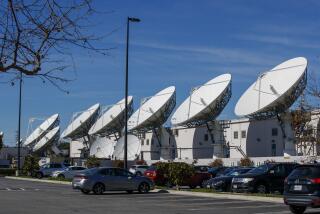A Change of Screen for Internet Users
- Share via
Ever since the Internet morphed from an academic exercise into a pop cultural phenomenon, electronics companies have been trying to move the Net onto simpler gizmos--the kind that technophobic parents can use as easily as their kids.
Their efforts will soon bear fruit in a new breed of TV, one that tunes in to the Net as well as the networks. At least eight manufacturers are expected to offer Internet-enabled sets this year, ranging from NadaPC’s $200 digital model to a $3,300 one from CMi Worldwide whose flat screen flips down from the underside of a kitchen cabinet.
This isn’t breakthrough technology. People have long been able to surf the Web on their TV sets by connecting them to set-top devices such as Microsoft’s WebTV. What’s new here is that the technology is built into the TV, rather than being housed in a separate box.
Consumers struggling with a growing stack of converter boxes, recorders and DVD players might welcome this kind of integration. It’s a risky investment, however.
Cable operators are likely to offer Internet services through their set-top boxes in the next few years, eliminating the need for an Internet-ready TV. And the unrelenting pace of change in the computer world suggests that any Internet technology built into a TV set could soon become obsolete.
These issues have convinced Microsoft executives that integrating WebTV functions directly into a TV isn’t a good idea. “Our experience in this space has shown that the TV is probably not the right place to innovate in the near term, for lots of reasons,” said Bruce Leak, president of Microsoft’s WebTV Networks Inc.
The best target for WebTV is homes without computers, Leak said, and that number is steadily shrinking. That’s one reason Microsoft is promoting a successor to WebTV, called UltimateTV, whose main feature is digital video recording.
Beyond that, it’s an open question just how interested consumers are in e-mail and the Web on TV.
“We learned through the school of hard knocks--and I think Microsoft did as well with the original WebTV Classic--that bolting a browser onto a television is not a successful consumer proposition,” said David Limp, executive vice president and chief strategy officer of Liberate Technologies. “The highways are littered with in-television Web-browsing products.”
Still, with the Internet gradually working its way into every aspect of life, TVs are a logical connection point. And the new, Web-enabled sets present some intriguing possibilities.
In general, the new sets will let viewers send and receive e-mail, browse the Web and shop online. Most offer a picture-in-picture or split-screen function that lets users watch a small TV picture while they’re on the Net.
To keep things simple and bug-free, the manufacturers won’t let users add or remove software. Any changes to the software will have to come from the manufacturers, which can install the software remotely through a set’s Internet connection. The trade-off is that buyers will have to rely on the manufacturers to update the software regularly to keep pace with the changes in game, audio and video technology.
Examples of the new breed include:
* A $200 NadaPC set, due in April, that can display high-definition TV pictures when connected to an HDTV receiver--a feature that costs 10 times as much or more in other sets.
The set, developed by CH.1 of Orange County, offers a measure of future-proof comfort for those concerned about the eventual transition from analog to digital TV, although its 27-inch screen might be too small to show off the full glory of HDTV. Its display provides twice as much detail as an analog set on regular broadcasts and Web pages.
The catch is that buyers have to pay NadaPC $21.95 per month for at least three years for Internet service. For those who already have an Internet provider they don’t want to leave, the additional $21.95 is probably a deal-killer. Otherwise, it’s a comparatively low price to pay for Internet access from both the computer and the TV.
* An $800, 16-inch set and a $1,000, 27-inch model from EspriTV, both expected this summer.
Like CH.1, EspriTV designed its Internet-enabled sets from the ground up, rather than adapting an existing model to display Web pages. The result, EspriTV officials say, is that Internet material is displayed with greater clarity.
Another plus is that consumers who have high-speed Internet accounts and Ethernet home networks can plug the EspriTVs directly into those networks. That way, they don’t have to tie up a phone line to use the TV’s Internet functions.
* A $600, 27-inch model from Zenith, due this summer.
This TV includes free Internet access from Transcast International Inc., which, like America Online, steers users to a pre-selected collection of entertainment, shopping, financial and lifestyle Web sites.
* An $850, 32-inch set from Panasonic, due in September.
Transcast’s programming and the Kerbango Internet radio service will be included with the TV, but Internet access will not. Panasonic plans to steer buyers to EarthLink, the nation’s second-largest Internet service provider.
* A $900, 9-inch combined Internet TV and DVD player from CMi Worldwide, due by April.
Internet access for the set, made by Samsung but marketed by CMi under the name Icebox, will cost $15 a month.
*
Times staff writer Jon Healey covers the digital living room.






